How To Save A Dying ZZ Plant? (+Common Problems & Solutions)
ZZ plants are sturdy plants that can survive through the worst living conditions. There have been times when I left for vacation, and My ZZ plant was just fine even after a month.However, not all plant owners can keep their ZZ plants alive. And if you are one of them struggling to keep your ZZ plant alive, hold on tight. Today, I will tell you my secrets to revive a dying plant.
Identify the problems, understand them, and take steps to troubleshoot and revive a dying ZZ plant. For instance, droopy leaves or sunburn indicate wrong lighting, and discolored leaves signify inadequate watering. Once the problem is identified, fix it by providing adequate living conditions to your plant.
There can be various reasons impacting your plant’s health. Reviving and keeping a dying plant healthy can be easy if you can determine the correct reason for the plant’s ill health. In this article, we will discuss determining the exact cause of pain in your ZZ plant and reviving your ZZ plant back to life.

Please note: Simplify Plants is reader-supported. Some links in the post are affiliate links and I get a commission from purchases made through links in the post.
How do you know when your ZZ plant is dying?
A dying ZZ plant will give you many clues to show their suffering. Leaves are the first to display the signs of stress.
Over time, the conditions can degrade if you neglect them.
Following are the signs that you might have noticed but didn’t pay any attention to:
- Yellow leaves
- Root rot
- Foul smell from the soil
- Brown blemishes on foliage
- Slow growth
- Leaves shedding
Understanding the underlying causes
Several issues can kill a ZZ plant.
It won’t kill the plant initially, but if you ignore the dying signs and do not take any action to troubleshoot the issue, your plant will die one day.
To save your ZZ plant, you must first know the underlying cause. Some common causes include:
- Overwatering and underwatering
- Poor soil and pot-type
- Too much or too little light conditions
- Pests and diseases
- Temperature and humidity issues
- Lack of nutrients
- No repotting for years
ZZ plants are sturdy plants that cannot be killed quickly.
However, it takes time to revive the plant when it is on the verge of death.
You need to first look for the primary cause of the suffering, and then you can find appropriate solutions.
It gets easier to solve the problem when you know why your plant is suffering rather than trying every solution and stressing it even more.
Let’s understand these causes and ways to save your dying ZZ plant.
1. Watering and moisture management
In this part, two things come to our minds: overwatering and underwatering.
Both can kill your ZZ plant.
So, you need to manage the watering and maintain correct moisture levels to keep your plant alive.
If you have already overwatered or underwatered your plant, and now it is suffering and dying, don’t worry.
There are solutions to bring your plant back.
Let’s understand how watering issues can kill your plant and how to revive a dying plant.
Overwatered ZZ plant
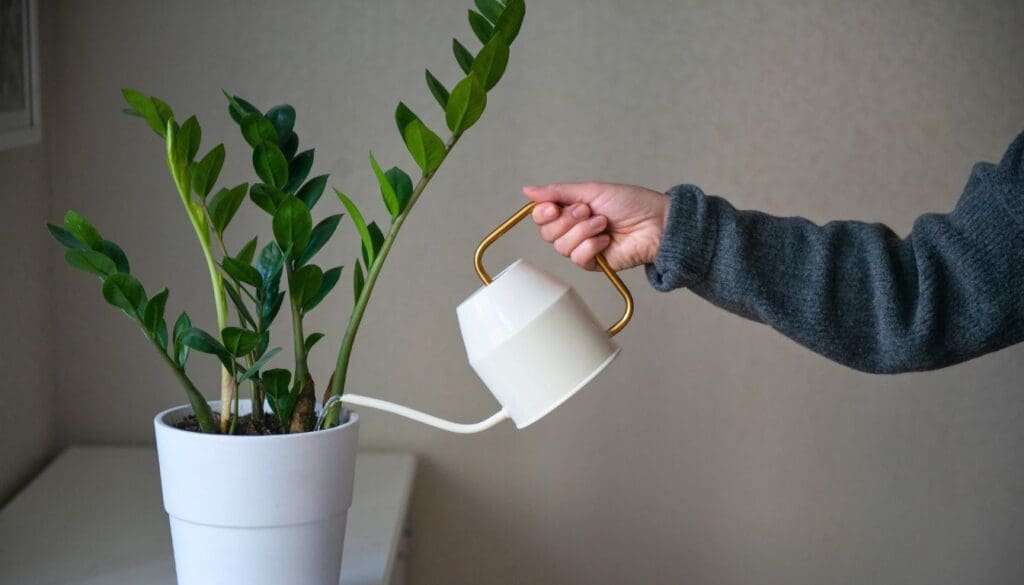
ZZ plants have an efficient rhizomatous root system that holds water, so they can stay without water for long periods.
Even their lustrous fleshy leaves can store water.
These plants do not appreciate overwatering.
These plants can stay alive and happy without water for long. With some extra watering, you’ll overwater them.
Signs of an overwatered ZZ plant:
- Root rot
- Brown leaves
- Yellowing foliage
- Leaves shedding
- Stunted growth
How to save an overwatered plant:
- Cut back watering and let it dry almost entirely.
- Give enough light to facilitate the drying of the soil. You can use grow lights to improve lighting.
- Consider aerating the soil from the top to allow airflow and fast moisture absorption.
- Check the drainage holes.
- Remove pale and brown leaves.
Prevention:
- Water your ZZ plant thoroughly but infrequently.
- Check the drainage system of the pot. It should allow excess water to pass within 1-2 minutes of watering.
- Let the plant dry out totally beneath the soil.
- Use a finger/skewer/stick to check the soil condition. Dig it up to 3-4 inches into the soil from the top. Take it out after a few seconds. Soil sticking to it indicates that the soil is still moist within.
- If confused, let it dry more rather than watering it.
- Watering can vary based on temperature, soil type, and living regions. Instead, monitor the plant and keep checking the moisture level regularly.
Also read: How much water do ZZ plant need?
Under watered ZZ plant
ZZ plants may suffer due to drought conditions, but you will hardly notice any outside changes.
As we know, ZZ plants can thrive even when you forget to water them for weeks.
That’s why some plant owners let the plant sit there without watering for weeks.
The ZZ plant will suffer if they are left unwatered for too long.
The lack of water will affect other plants’ functions, i.e., nutrient uptake and airflow, leading to a slow decline.
Signs of an underwatered plant:
- Droop and curled leaves
- Pale leaves
- Soil pulling away
- Leaves falling over
- Slow growth
- Brown edges
How to revive a dehydrated ZZ plant:
- Trim off damaged foliage.
- The next step is thoroughly rehydrating your ZZ plant with water until the excess water drains out.
- If you are unsatisfied with this watering method, use the bottom watering method.
- Put a tray and pour some water into it. Keep the plant over the tray (roots should not touch the water).
- Let it be for an hour. The roots and soil will take water through capillary action.
- Remove the tray and let the plant dry.
Prevention:
- Check the moisture levels regularly.
- Use soil with good retention qualities.
- Give your ZZ plant a drink when it is thoroughly dry.
- Allow air circulation around the plant.
- You can use the moisture meter to determine the soil’s moisture level now and then. This way, you will never miss watering.
2. Assessing soil and pot conditions
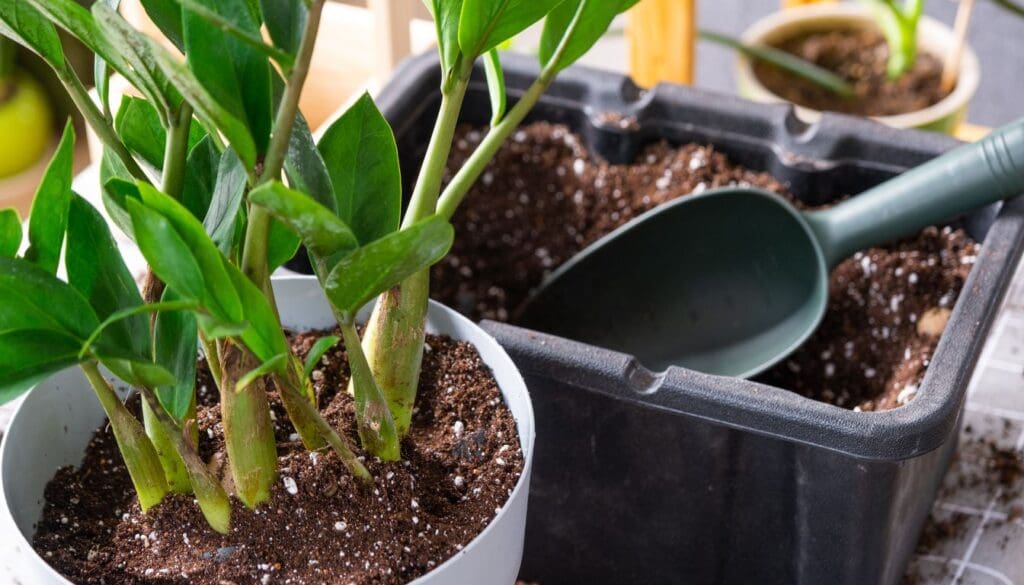
ZZ plants are tough and can survive in various soil types.
But for their best performance, you must plant them in suitable soil.
The soil should drain the excess while retaining the required moisture.
It also needs to be fertile with 6-7 pH levels.
With poor drainage, the water will stay stagnant around the soil, causing overwatering and root rot.
With poor retention qualities, the soil won’t hold the necessary moisture and nutrients.
For this, it might suffer from frequent dehydration and nutrient deficiency.
When you recently plant or repot the ZZ plant, fertile provides the necessary nutrients.
But infertile soil can stress the plant.
The absence of these features can weaken and kill your plant slowly.
A pot without drainage holes also contributes to overwatering and root rot.
Signs of wrong soil and pot:
- Water is not draining out of the holes or draining immediately.
- The soil stays wet for too long or gets dry very quickly.
- Stagnant water.
- Discolored and curly leaves
- Stems shriveling and wilting
Correcting the soil and pot type to save a dying ZZ plant:
If your plant dies despite proper watering techniques, the problem is with the soil or pot.
Adjust the soil mix by adding perlite, coarse sand, or peat moss to fix this.
Or, you can repot it with new, suitable soil.
A recommended soil mix is 2 parts all-purpose potting mix, 1 part coarse sand, and 1 part perlite.
You can even use cactus or orchid soil mixes.
These provide good drainage and retention.
Check out our ZZ plant Soil article for the ideal soil mix recipes.
For pots, we recommend terracotta pots with drainage holes.
These don’t hold moisture for long and allow the roots to breathe.
Prevention:
To prevent the above issues, research the ideal soil and pot types, buy the right one, and then plant your ZZ plants.
Use suitable soil mixes that are good in drainage, retention, and fertility. Also, check the pH using a pH tester.
For commercial mixes, try Ocean Forest Potting Soil, Espoma Organic Cactus Mix, and FoxFarm Happy Frog Potting Soil.
For pots, always go for terracotta pots.
While plastic pots are acceptable, the ZZ plants’ rhizomes can grow very fast and wrap or crack the plastic pots.
So, terracottas would be better.
Also read: Overwatering vs Underwatering
3. Managing the Light requirements
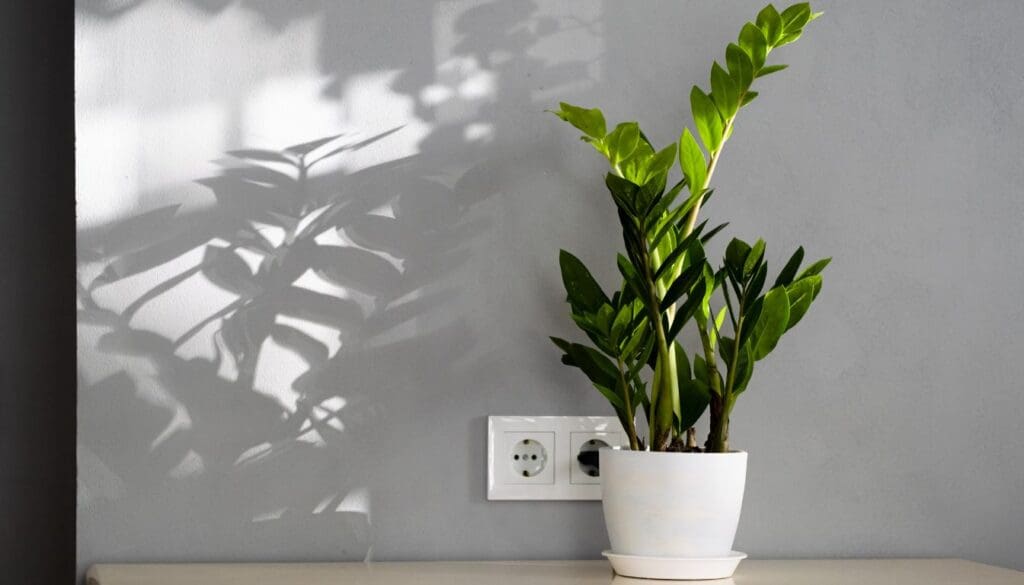
ZZ plants grow faster in suitable light arrangements.
However, too much of the same can generate free radicals that can destroy the plant.
Too little sun is also not the best option for your ZZ plant.
You will not see your plant dying but may see other signs indicating the plant’s downfall.
Signs of too much light:
- Sunburn
- Brown blotches
- Poor vigor
Signs of low light conditions:
- Droopy leaves
- Browning leaves
- Poor growth
- Leggy stems
Fixing light issues to save the plant:
- If your ZZ plant got a sunburn or issues related to extreme exposure, then your plants either need a shed or another spot.
- If your plant is outdoors, install a shade over it or move it inside.
- If your plant is kept near a window, move it a few feet away or use a sheer curtain to filter the light intensity.
- If your ZZ plant is not getting enough sun, relocate it to a spot to receive 6-8 hours of indirect sun.
- You can place it in the east or west-facing windows.
- Use artificial light if your home does not receive enough light.
Prevention:
- Your ZZ plant loves light but with moderate intensity.
- Keep your plant in any spot you like, ensuring it gets 6-8 hours of indirect light. Put up curtains beforehand once the intensity increases.
- A few hours of direct light from the morning sun won’t harm.
- Keep an eye on your plant when moved to the new spot.
- Please don’t move the plant in one go. Gradually move the plant to make it comfortable with the environment and shift.
4. Feeding and fertilizing

ZZ plants need a fertile soil mix.
However, soil can lose its nutrients over time.
In that case, fertilization comes to the rescue.
Nutrition is essential for the ZZ plant, whether you provide it through the soil or fertilization.
Lack of nutrients will lead to yellow or pale leaves.
The plant will survive but won’t thrive or stay strong.
Once the weak plant receives any severe issue, it can’t fight back and dies.
Signs of improper fertilization:
- Discolored leaves
- Small leaves and stunted growth
- Plant not developing
- Plant wilting and dying
Saving a nutrient deficit ZZ plant from dying:
If you suspect a nutrient deficiency, use fertilizers to boost plant growth.
Feed your ZZ plant once a month throughout the growing season.
A balanced liquid fertilizer with NPK 10-10-10 or 20-20-20 should work well.
Make sure not to over-fertilize, as that can also kill your plant.
Stop fertilizing in winter. Since it would stay dormant, the least care is needed.
Prevention:
Fertile soil can provide enough nutrition, but it isn’t enough.
Fertilize the plant after a few weeks of planting or repotting.
Continue this throughout the growing season.
Use a balanced liquid fertilizer.
Always begin with small amounts to avoid over-fertilization.
5. Correcting Overfertilization

While fertilization is essential to provide the plant with adequate nutrients, you should not overfeed your plant.
When overfertilized, there will be a salt buildup in the soil.
As a result, the roots of the ZZ plant won’t be able to take up the nutrients.
The salt buildup for prolonged periods can burn and damage the roots, ultimately killing the plant.
Signs of overfertilization:
- Leaf discoloration
- Wilted leaves
- Brown tips and edges on the leaves
- Stunted or no growth in the plant
- The soil surface has a white layer
- Roots are white and covered with brown spots
Saving an over-fertilized ZZ plant
If you suspect overfertilization, you can save your dying plant by leaching the soil.
To flush the soil, consider thorough and deep watering.
Continue to water until it starts coming out of the drainage holes.
Along with the water, the salts will come out too.
Let the water sit for some minutes, and then water your plant again.
Repeat the process until clear water emerges from the drainage holes.
Once you have flushed the soil, avoid fertilizing for weeks to let it recover.
Prevention:
Less is more.
Provide less if you are a beginner and do not know the fertilizer amount.
Fertilize with a liquid fertilizer once a month.
Liquids are easy to use.
Remember to dilute your fertilizer with water.
It reduces the concentration and prevents burns.
Consider flushing your soil once a month to prevent salt buildup and root burns.
Also read: How much light do ZZ plant need?
6. Maintaining adequate temperature levels

ZZ plants prefer warm temperatures to thrive and stay healthy.
During winter, when temperatures drop below 50-60°F, the plant will suffer as cold ceases its activity.
The inappropriate temperature around the plant for longer periods can even result in your plant’s death.
Additionally, scorching temperatures can also be detrimental.
Exposed to temperatures above 90°F for prolonged periods can kill your ZZ plant.
Signs of Cold drafts:
- Discolored/Disfigured leaves
- Puckering of young leaves
- Brown blotches in mature leaves
- Wrinkled leaves
- Distressed plant
Signs of heat stress:
- Leaves turning brown and crispy at the edges
- Wilting or drooping
- Stunted growth
- Shedding leaves
Saving a ZZ plant from cold drafts:
- Move the plant to a spot where the temperature level is higher or where they are least subject to cold.
- Light the furnace and keep the plant a few feet away to monitor cold temperature levels.
- Let it have indirect sunlight during the day. Use Grow lights to provide warmth.
- Prune damaged leaves.
- Use heat mats.
Saving a ZZ plant from hot temperatures:
- Move your plant to a cooler location.
- If it is outside or on the balcony, shift it indoors or to a shady spot.
- Ensure good air circulation for the plant.
- Mist the plant and increase a little watering to keep the plant cool.
- Once the temperature becomes ideal, the plant will recover and revive.
Preventing cold drafts and heat stress:
- Keep your plant in the least exposed place to the cold breeze.
- A well-ventilated, shelter-lit spot would suit your ZZ plants during cold weather.
- Don’t keep the plant near the window. The leaves should not touch the window as the cold breeze will directly affect the leaves’ health.
- Keep misting your plant to keep it cool during hot climates.
- If they are close to open windows for sunlight, put up sheer curtains or Venetian blinds to stop the heat from reaching your ZZ plant.
- Don’t keep the plant too close to furnaces, radiators, air conditions, or heating or cooling systems.
7. Adjusting the humidity levels for the ZZ plant

ZZ plants tolerate different humidity ranges with no strain at all.
Still, extremely low or high humidity levels make a perfect environment for pests and diseases to take over.
There are signs given by plants showing that the humidity level is not appropriate and needs to be monitored.
We also need to take care of the environmental changes by moving the plant to a favorable environment or creating such conditions for the plant’s health.
Signs of low humidity levels:
- Fungal diseases
- Pests infestation
- Brown tips
- Dried leaves
Saving a ZZ plant suffering due to low humidity:
- Use a pebble tray to increase the humidity around your ZZ plant.
- Take a tray about 1 inch deep and fill it with small stones.
- Fill the tray with water and set the plant on the tray. The water will gradually evaporate and add moisture around the plant.
- Another way is by grouping a few plants. It is the most inexpensive way.
- The plants will release moisture through transpiration, and humidity will go up.
- Add a humidifier to increase humidity and a dehumidifier to reduce it.
Prevention:
- Buy a hygrometer to know the humidity level in your room. Move the plant to an appropriate humid room.
- ZZ plants prefer humidity levels around 40%-50% but can tolerate some variation.
- You can use a humidifier/dehumidifier to regulate the appropriate humidity level around your ZZ plant.
- Do not mist or splash water on the plant.
- Avoid extreme high humidity around the plant for a long time.
Also read: Does ZZ plant need misting? (+Ideal humidity)
8. Repotting a struggling ZZ plant
When a plant becomes root-bound, the roots start growing circularly.
Over time, they will come out of the soil surface and drainage holes.
As this happens, the roots can strangle and suffocate themselves and the plant.
If not repotted in time, this condition will increase daily, eventually leading to the plant death.
Root-bound ZZ plants can also become susceptible to infections because it weakens the plant.
And a weak plant becomes an easy target for pests and diseases.
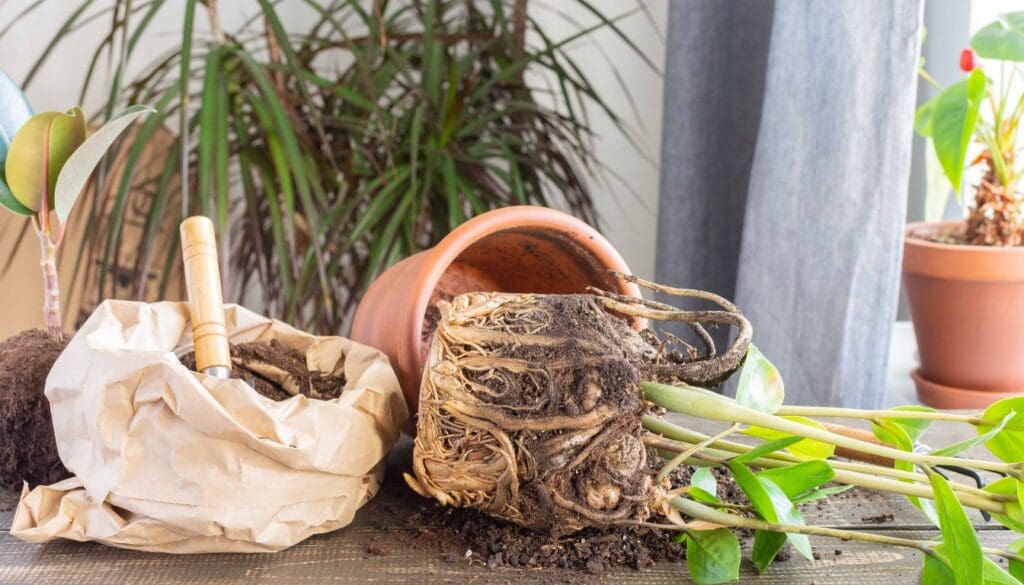
Signs your ZZ plant requires repotting:
- Roots coming out of the soil surface and drainage holes
- Roots circling the pot edges
- No development in the plant
- Wilting or drooping
Saving a dying ZZ plant by repotting:
The only solution is to repot it.
Choose the ideal soil mix and a one-inch larger pot than the previous one.
Take the plant carefully out of the pot.
Since the roots will be very entangled, be patient and gentle.
If it seems difficult, you might have to break the pot.
Since the roots will be long and entangled, consider pruning some roots.
Lastly, replant the plant in a pot with new soil mix and water it.
Provide proper requirements, and avoid fertilizing the plant for some weeks.
Prevention:
You must repot the ZZ plant on time to prevent it from dying due to root-bound.
ZZ plants are slow growers, so they won’t require frequent repotting. You can repot them every 2-3 years.
Do it in the spring or summer.
Since it is their growing season, it will recover from transplant shock quickly.
9. Pest Management in ZZ Plants

Pests are irritating and stubborn as they might hide under the leaves you might overlook for a long time.
They make the plants weak by sucking the sap out of them.
The plant will look ill suddenly.
They almost stop functioning, unable to generate energy to grow and supply the nutrients all over the plant, causing the plant’s death.
Signs of pest infestation:
- Lifeless leaves
- Browning and yellowing of foliage
- Speckled leaves
- Decaying leaves and stems.
- Slow growth
Saving a pest-infested ZZ plant:
- Separate the infected plant and examine its condition for a minute. If a lot of leaves are damaged, the infestation will be severe.
- As such, the plant may not survive. You can take any cuttings from the plant if any healthy stem or leaf is available and propagate the same.
- If the condition is not severe, trim the severely damaged leaves.
- Washing the plant with a strong stream of water will help eliminate the pests.
- Spray neem oil solution over your plant every few days until all the pests are killed.
- Spray horticultural oil all over the plant until the infestation is gone.
- You can also use cotton dipped in alcohol and clean the leaves and undersides to remove stubborn pests.
Prevention:
- Always keep a check on your plant to know how your plant is.
- You can use neem oil spray as a preventive measure for pest infestation.
- Never overwater your ZZ plant, and also fertilize once a month.
- Provide good air circulation around the plant.
- Do not propagate contaminated soil and cuttings.
10. Disease management in a ZZ plant
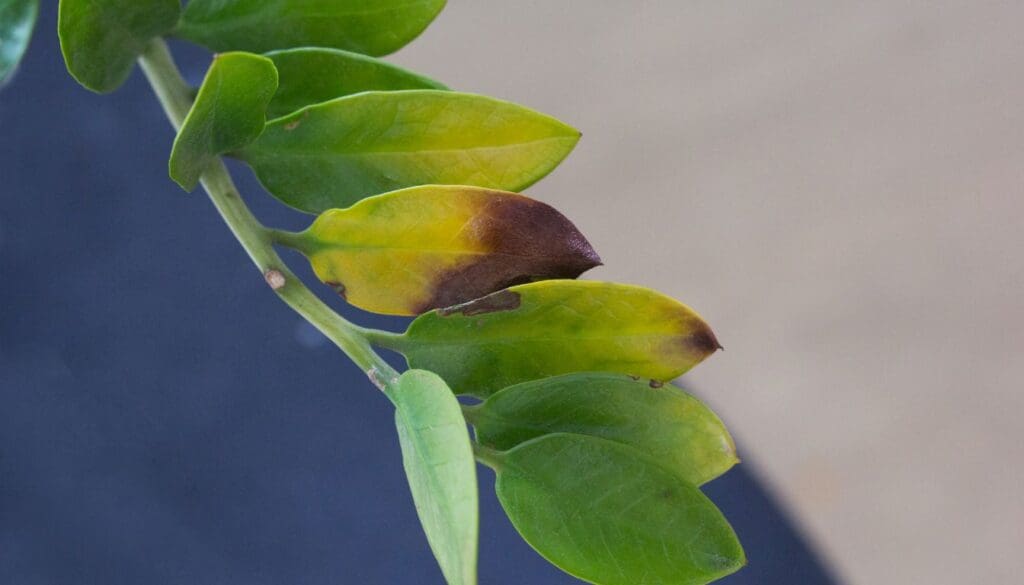
Diseases like root rot and leaf spots can kill your ZZ plant.
Root rot
Root rot is like a red signal for any plant parent to stop with whatever they are doing.
This situation occurs when the root system is almost destroyed due to rot or fungal growth.
Overwatering is the prime reason for this situation, but we cannot ignore other factors that work as icing on the cake (here in a bad way).
Possible signs of root rot:
- Slow growth
- Yellowing foliage
- Smaller leaves
- Wilted leaves
- Thinner canopy
- Pale leaves
- Decaying branches
- Weak plant
Saving a ZZ plant with root rot:
Since it’s a fungal disease and roots get compromised, immediate action is necessary, no matter the weather.
Here’s how you can save a dying ZZ plant from root rot:
- To ensure it is root rot, see if you get any foul smell from the plant base or the soil. It indicates a root rot.
- Take the plant out of the pot to closely examine the roots’ condition.
- Healthy roots are white and firm. If they are brown, mushy, and come out easily by touching, your plant is suffering from root rot.
- Use sterilized scissors to cut out the rot and damaged roots to encourage new growth.
- Spray the healthy roots with fungicide to eliminate the fungus.
- Sterilize the scissors to prevent contamination or further spread of the fungi to other plants.
- Repot the plant in a porous pot (preferably) and fresh, well-draining soil mix to avoid reoccurrence of the same situation.
- Ensure a proper drainage system in the pot and water only when the soil is dry entirely.
Prevention:
- You need to take care of the watering regime.
- Taking care of watering will take a lot of care of roots and soil from decaying.
- Give your plant enough light, whether natural or artificial, so that the soil dries faster.
- Check the drainage system of your plant’s pot.
- Never keep the soil soggy.
Also read: Is my ZZ plant root bound?
Leaf Spot
Fungi and bacteria lead to Leaf Spot disease.
The leaves will first become brown and start falling off.
Over time, the disease will spread, and the plant will die.
The spots start with a yellow blotch on the leaf surface, edges, or tips.
Over time, they turn black.
Once this happens, the leaves become beyond recovery.
All the leaves will die over time, and so will the plant.
A ZZ plant can have several diseases, but these two can kill your plant.
Signs of a diseased ZZ plant:
- Leaf edges and surfaces having yellow blotches
- Leaves have brown and black spots with a yellow halo.
- Stems are soft and rotting.
- Stunted growth
Saving a dying ZZ plant:
- Quarantine your plant immediately from the other plants to avoid spreading the disease.
- Cut off the infected and damaged leaves.
- If the damage level is less, there is a chance of survival.
- Repot your plant with a new soil mix.
- Maintain good air circulation around the plant.
- Spray some fungicides or bactericides to prevent the disease from spreading further.
- You can try homemade fungicide by mixing 1 tablespoon baking soda with 1-quarter of water. Spray it on the infected leaves. Do it until the spots disappear.
Prevention:
Prevention is the best thing.
Once infected, it becomes very challenging to revive the plant.
To prevent the disease from killing your ZZ plant:
- Keep the surroundings clean.
- Provide the plant with the correct requirements.
- Check your plant daily for diseases.
- If you ever find initial signs of the disease, isolate it, prune prudently, and spray fungicide. It will prevent the disease from spreading and won’t kill your plant.
Also read: Is my ZZ plant root bound?
11. Pruning and Trimming
Once you have identified the above issues and taken steps to fix them, it is time to take a few more steps to revive your plant.
Prune and trim the dead and damaged leaves from the plant.
Pruning will stop the plant from wasting energy behind trying to revive the damaged leaves and allow it to focus on new growth.
Throw away these pruned leaves and keep the surroundings clean.
It will discourage pests and diseases further.
12. Creating a supportive environment
You must create a supportive environment to help the plant recover and encourage optimal growth:
- Ensure the plant receives bright indirect sunlight daily for 6-8 hours. When the intensity increases, put up curtains to filter the direct sunlight.
- Regularly check the moisture level with your finger and water the plant when the maximum soil has dried. Let it be if the soil is still wet.
- Feed your plant once it has recovered a little. Begin with minimal amounts. As I said, little is more.
- Adjust the temperature and humidity levels. Temperatures should be within 65-80°F, and humidity should stay within 40-50%. Keep them away from cold drafts, and avoid rooms containing HVACs, radiators, or generators.
- Keep checking for further infestation.
13. Monitoring and Patience
Monitor your plant daily to observe and understand its behavior against the care you are providing.
Since you are trying to bring it back from the verge of death, you must be patient and give it enough time to recover.
If you find new leaves, your plant is recovering.
Do not overdo anything or neglect your plant just because it is recovering.
Be patient, and continue caring for the plant as you did.
Final Words

ZZ plants are sturdy, but you cannot follow some thumb rules while growing them. They need indirect bright light the whole day, i.e., neither too intense sun nor too low light. Watering should be in control; always water less or don’t water when in doubt.
The plant should be allowed to dry between watering. Keep the temperature in moderation and humidity around 40-50% around the plant. Try experimenting because different rooms have different humidity. Monitor and identify what humidity and temperature level they prefer by raising and lowering humidity levels.
Do not follow any strict routine. Always examine what your plant looks like and what environment they are most happy in. If the plant cannot be revived, you must grow new plants. Either buy them or find good plant parts to propagate them through cuttings.
How often should I fertilize my ZZ plants?
Feed them once a month throughout their growing season. Avoid fertilizing them right after planting or repotting. Start after a few weeks. There is no need to fertilize them in winter as they’re dormant.
Do ZZ plants need high humidity?
Humidity for these plants is average. 40-50% of humidity levels would be fine for them. Extremely low or high can be detrimental.
Sources: ZZ plant study, College of agricultural studies, University of Vermont, National science foundation.
Recommended Garden Supplies
| Product Image | Our Recommended Gardening Supplies | Check Offers! |
|---|---|---|
Top Top
Top
Top
Top
Top
Top
Top
Top | rePotme Houseplant and Tropical Classic Potting Soil Mix | Check Offer On Amazon |
 Top
Top
Top
Top
Top
Top
Top
Top | Espoma Organic Indoor Plant Food | Check Offer On Amazon |
 Top
Top
Top
Top
Top
Top
Top
Top | GooingTop LED Grow Light 6000K Full Spectrum Clip Plant Growing Lamp | Check Offer On Amazon |
 Top
Top
Top
Top
Top
Top
Top
Top | Soil Moisture Meter | Check Offer On Amazon |
 Top
Top
Top
Top
Top
Top
Top
Top | Govee Hygrometer Thermometer, Bluetooth Enabled! | Check Offer On Amazon |
 Top
Top | LEVOIT Humidifiers for Large Room(Best For Plants) | Check Offer On Amazon |
 Top
Top
Top
Top
Top
Top
Top
Top | Upgraded DIY Automatic Drip Irrigation Kit, 15 Potted Houseplants Support | Check Offer On Amazon |
 Top
Top
Top
Top
Top
Top
Top
Top | Stainless Steel Heavy Duty Gardening Tool Set | Check Offer On Amazon |
 Top
Top
Top
Top
Top
Top
Top
Top | Bonide Insecticidal Soap | Check Offer On Amazon |
 Top
Top
Top
Top
Top
Top
Top
Top | Bonide 32 oz Spray Neem Oil for Organic Gardening | Check Offer On Amazon |
 Top
Top
Top
Top
Top
Top
Top
Top | Garden Safe Fungicide | Check Offer On Amazon |

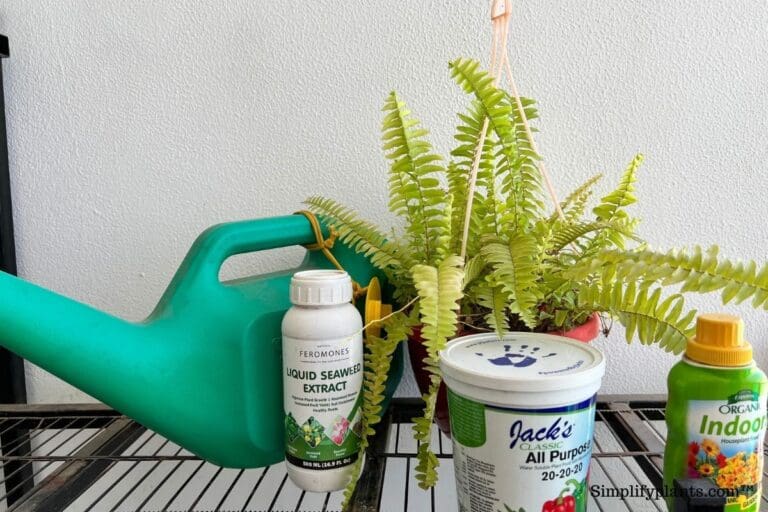
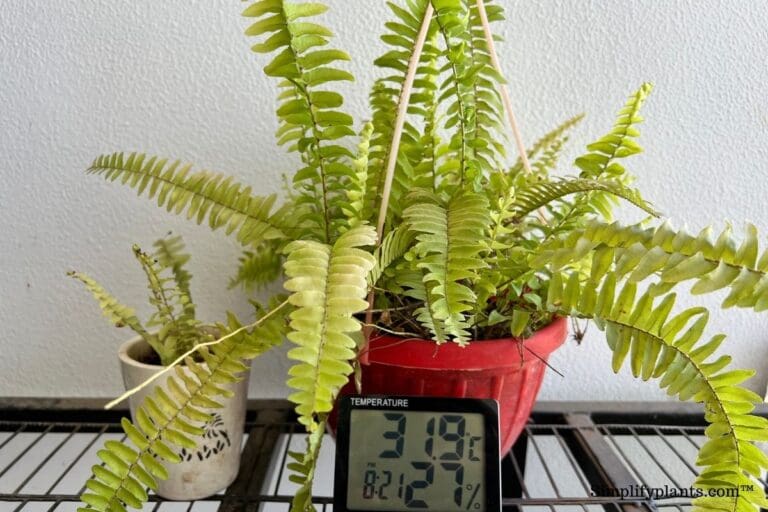


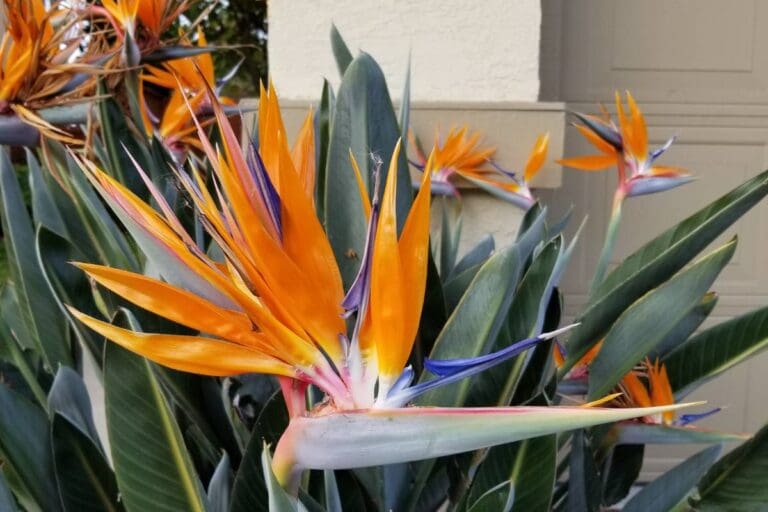

Aw, that was an exceptionally nice post. Spending some time and actual effort to produce a great article… but
what can I sɑy… I put things off a whole lot and don’t manage to get anything done.